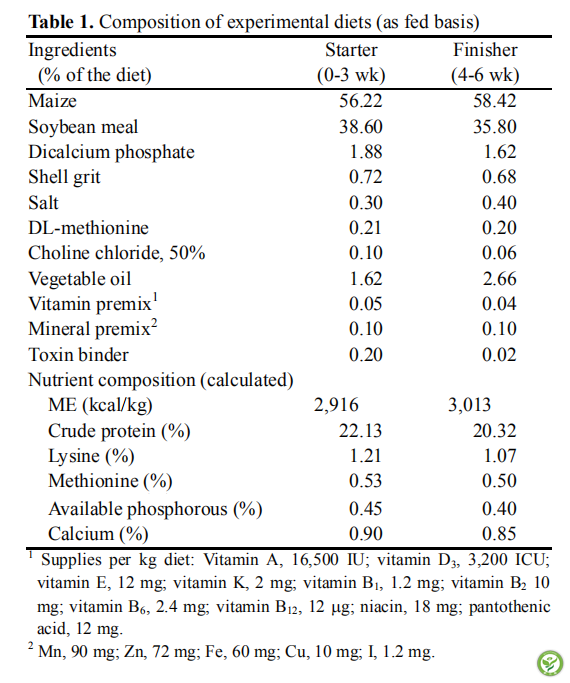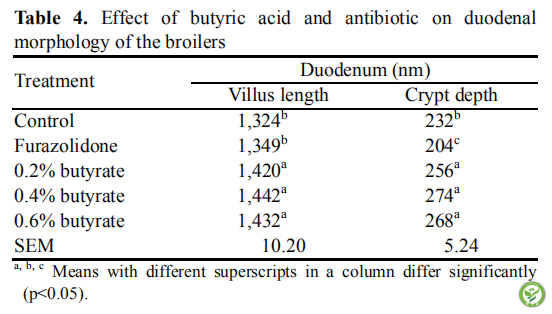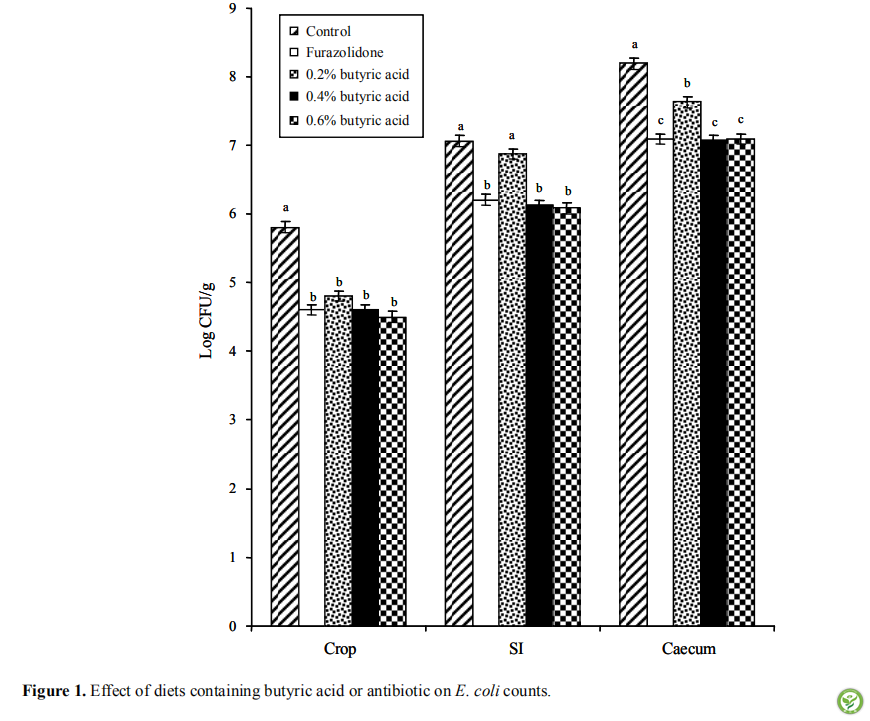Effect of Butyric Acid on Performance, Gastrointestinal Tract Health and Carcass Characteristics in Broiler Chickens
作者:A. K. Panda*, S. V. Rama Rao, M. V. L. N. Raju and G. Shyam Sunder
Project Directorate on Poultry, Rajendranagar, Hyderabad, 500 030, India
来源:Asian-Aust. J. Anim. Sci. Vol. 22, No. 7 : 1026 -1031 July 2009
DOI:10.5713/ajas.2009.80298
翻译:肠动力研究院 梁琦
【摘要】丁酸(BA)是一种短链脂肪酸(SCFAs),据报道丁酸在促进动物的肠道上皮发育、改善胃肠道健康、抑制病原菌活性上发挥着重要作用,是一类非常具有潜力的替抗物质。当前,有关于丁酸在家禽上的应用研究非常少,本文旨在研究不同添加水平的丁酸对雏鸡生产性能,胃肠道健康和胴体特性的影响。240羽1日龄雏鸡被随机分成5组,1)对照组:喂食基于玉米的基础日粮;2)抗生素组:饲喂0.05%呋喃唑酮+基础日粮;3)0.2%BA组:喂食0.2%丁酸+基础日粮;4)0.4%BA组:饲喂0.4%丁酸+基础日粮;5)0.6%BA组:喂食0.6%丁酸+基础日粮。每组6羽,8个重复,试验为期5周,其中前3周喂食初始对照日粮(含有2900 Kcal ME/kg和22% CP),后2周饲喂育肥日粮(含有3000 Kcal ME/kg和20% CP)。每周记录每羽肉鸡的体重和采食量以计算饲料转化率,并于第22、35天每组致死一定数量的肉鸡,收集相关脏器用以分析相关指标。结果显示,0.4%BA组的肉鸡在维持体重增加和减少大肠杆菌计数方面与抗生素组相似,但饲料转化率却显著更高。但是,将日粮中丁酸的浓度从0.4%提高到0.6%,却没有获得这些参数的附加优势。饲料的摄入量和死亡率不受日粮处理的影响。与对照组或抗生素组相比,日粮添加丁酸可观察到肉鸡上消化道(嗉囊,前列腺和胃)的pH值降低。与0.2%丁酸相比,0.4%的丁酸降低肉鸡上消化道pH值更有效(p <0.05)。而在下消化道中,0.4%和0.6%的丁酸可有效降低十二指肠的pH,但在空肠或回肠均未见效果。不管丁酸的添加水平如何,在所有使用丁酸处理的日粮中十二指肠的绒毛长度和隐窝深度均显著增加(p <0.05)。与对照组或抗生素组相比,所有丁酸处理组的胴体量显著更高且腹脂含量显著更低(p <0.05),研究结果表明,日粮添加0.4%的丁酸可维持肉鸡的生产性能,肠道健康以及绒毛发育和胴体质量。
【关键词】丁酸;生产性能;胃肠道健康;胴体特性;肉鸡
以下是相关图表
表1:试验日粮的组成(以饲喂为基础)

表2:饲喂含丁酸或抗生素日粮的肉鸡的生产性能

表3:饲喂含丁酸或抗生素日粮的肉鸡胃肠道片段的pH

表4:丁酸和抗生素对肉鸡十二指肠形态的影响

图1:含丁酸或抗生素的日粮对大肠杆菌计数的影响。

表5:饲喂含丁酸或抗生素日粮的肉鸡胴体特征

结论
在本研究中,日粮添加0.4%丁酸在维持肉鸡体重增加和减少大肠杆菌计数方面与抗生素组相当,并发现其饲料转化率更高。日粮丁酸还可以观察到除抗生素以外的其他一些刺激作用,例如刺激肠绒毛生长,提高胴体质量和降低腹脂含量。从本研究的结果可以得出结论:0.4%丁酸可以完全替代肉鸡日粮中的抗生素。
Abstract
An experiment was conducted to study the effect of graded levels of butyric acid (butyrate) on performance, gastrointestinal tract health and carcass characteristics in young broiler chickens. Control starter (0-3 wk) and finisher (4-5 wk) diets were formulated to contain 2,900 kcal ME/kg and 22% CP, and 3,000 kcal ME/kg and 20% CP, respectively. Subsequently, four other experimental diets were formulated to contain 0.05% antibiotic (furazolidone) or 0.2, 0.4 and 0.6% butyric acid. Each diet was fed at random to 8 replicates of 6 chicks each throughout the experimental period (0-5 wk). The results showed that 0.4% butyrate in the diet was similar to antibiotic in maintaining body weight gain and reducing E. coli numbers but superior for feed conversion ratio. No added advantage on these parameters was obtained by enhancing the concentration of butyrate from 0.4 to 0.6% in the diet. Feed intake and mortality were not influenced by the dietary treatments. A reduction in pH of the upper GI tract (crop, proventiculus and gizzard) was observed by inclusion of butyrate in the diets of broilers compared to either control or antibiotic-fed group. Butyrate at 0.4% was more effective in reducing the pH than 0.2% butyrate. Within the lower GI tract, 0.4 and 0.6% butyrate was effective in lowering pH in the duodenum, but no effect was found in either the jejunum or ileum. The villus length and crypt depth in the duodenum increased significantly in all the butyrate treated diets irrespective of the level tested. Carcass yield was higher and abdominal fat content was lower significantly in all the butyrate treatment groups compared to the control or antibiotic group. From these findings, it is concluded that 0.4% butyric acid supplementation maintained performance, intestinal tract health, and villi development and carcass quality in broiler chickens.
Key Words : Butyric Acid, Performance, GI Tract Health, Carcass Characteristics, Broiler Chickens
Conclusion
In the present study, 0.4% butyric acid was on par with antibiotic in maintaining body weight gain, and reducing E. coli numbers and found superior for feed conversion ratio. Several additional effects that go beyond those of antibiotics such as stimulating the villi growth of intestine, higher carcass yield and low abdominal fat content were also observed by dietary addition of butyrate. From the findings of the present study, it is concluded that 0.4% butyric acid could totally replace antibiotics in broiler chicken diet.
如您需原文,请联系本文作者和出版方,或请垂询肠动力研究院。本网站发布的所有资料将尽最大可能注明出处、作者及日期,如无意中侵犯了您的知识产权,请来信及时告知,我们将立即予以删除。
All information released by the WeChat Official Account will do its best to indicate the source, author and date. If we inadvertently infringe on your intellectual property, please inform us in time and we will delete it immediately.





